You’re thinking about trying skydiving. Or maybe a friend/family member is. Or maybe you just need a few minutes’ break from work or your amazingly awful blind date, and this article sounded like the perfect activity to kill time while you’re hiding out in the bathroom. Let’s have some fun with this! These are the top questions we get asked all the time about skydiving, so we figure you have some of the same ones.
I’m afraid of heights… I probably shouldn’t jump, right?
Not true! Many licensed and professional skydivers are or were afraid of heights. They say heights and altitude feel different, and that at higher altitude (like in freefall), their fear of heights isn’t triggered at all because the ground is literally miles away. They may feel a little nervous when approaching the ground to land, but that is only one small part of the skydive and that’s much easier to overcome for a great experience.
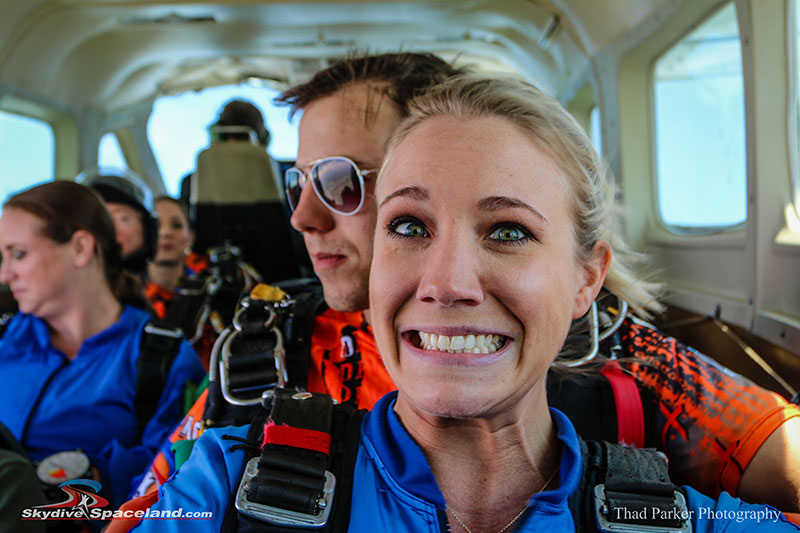
How fast do you fall?
About 120 mph! Ever drive that fast? (Yeah, me either 😉 )
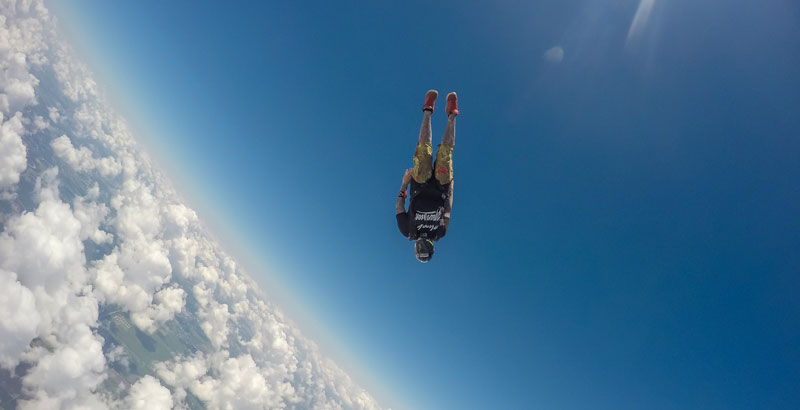
How safe is skydiving?
Nothing is 100% safe, not even eating popcorn on your couch (what if you choke?!). But skydiving is as safe as we can make it, especially tandem skydiving for first-timers. At Skydive Spaceland we use top of the line gear, experienced and well-trained instructors and pilots, proven safety procedures, and well-maintained aircraft to keep risks as low as possible. Nobody has a death wish; we want to skydive a LOT!
The United States Parachute Association reports that you are statistically much more likely to be killed by lightning, a bee sting, a dog bite, or legal execution (yikes!).
What does skydiving feel like? Does your stomach drop like on a roller coaster? Is it physically hard to do?
It’s a little like riding a T. rex carrying bazookas through a rainbow with a lot of wind in your face! OK, just kidding… kinda. Seriously though, physically it’s crazy windy with a spectacular view and you won’t notice much else in freefall. You don’t feel your stomach drop like on a roller coaster, because that feeling comes from the floor dropping out from under you and you feeling unsupported. When you jump out of an airplane, you’re jumping into about 100 mph of wind and while you *know* you’re falling, your body doesn’t feel unsupported like it does on a roller coaster.
People sometimes say it’s hard to breathe in freefall because the air is going by so fast, but we just say to scream–you’ll catch that breath on the flip side, guaranteed. 🙂
The harness may feel tight, but you know if you’re jumping out of an airplane you really don’t want it to be loose! Just wear comfortable, relatively form fitting clothes that won’t bunch up under the harness.
As for whether tandem skydiving is physically hard, it’s about as easy as falling out of an airplane… 🙂
Is it like the wind tunnel? I did that already.
Yes and not even close! The feel of the wind on your body is very similar. However, nothing beats the craziness and camaraderie of actually training for a skydive, getting in the plane, and stepping out that open door 2.5 miles up in the sky with your new lifesaving best friend, all the way out of your comfort zone. Plus the view is way better in the sky than the walls of a tunnel!
How often do people throw up?
Honestly, it’s pretty rare. It can be kind of spectacular, though, especially if you got video. Don’t worry, we’ll do our best to edit that out of your video!
Jump altitude–does it really make a difference how high you jump out of the plane?
No, and yes. The basic act of skydiving–jumping out of a perfectly good airplane, freefalling, and deploying/flying the parachute–won’t change much whether you jump from 8,000 or 18,000 feet. However, most first-timers are so sensory-overloaded that freefall goes by SOOOO fast (around 120 mph to be precise), and they just wish it would have lasted longer!
In the U.S., we can jump from up to 15,000 feet MSL (above sea level) without prebreathing supplemental oxygen. How high you jump on a given skydive can vary based on how powerful the airplane is, how high the airport is where you’re jumping (Mile-High City, anyone?), whether air traffic control in your area limits your altitude, and weather. Also, some skydiving centers sell a less expensive, lower-altitude skydive (such as 10,000 feet) to get you in the door and then upsell you on a higher altitude. Some offer a super-high skydive from 18,000 feet or more, but you have to prebreathe oxygen on the way up and these jumps are significantly more expensive. If you’re shopping skydiving centers, make sure you’re comparing apples to apples, not mountains to molehills.
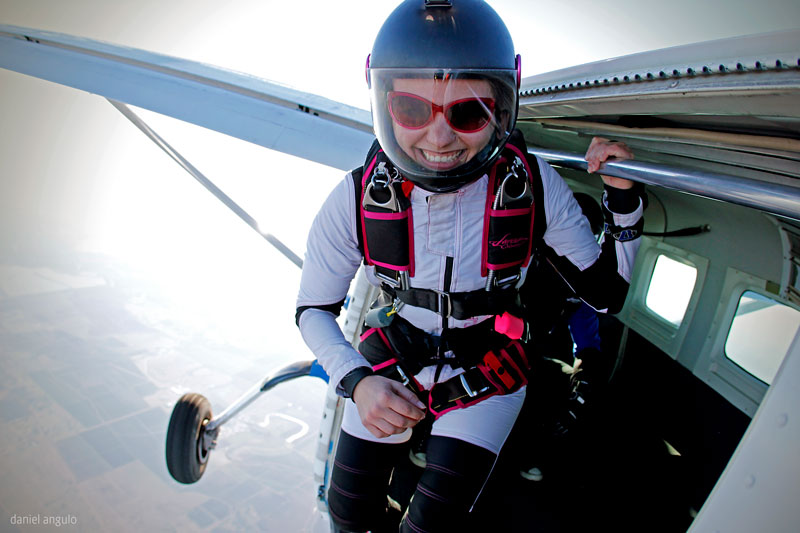
At Skydive Spaceland, everyone jumps from around 14,000 feet so you get the highest skydive possible without the added hassle and expense of prebreathing oxygen. This gives you about 8,000 feet of freefall, which is just about one minute of possibly the most intense fun you’ve ever experienced! If you were do to a skydive from 10,000 feet, you’d get only about 27 seconds.
How old do you have to be to skydive?
In most places, at least 18 years old. Bring your ID. If you’re not 18 yet, wouldn’t skydiving be a great 18th birthday gift?
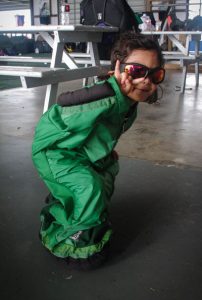
Is there a weight limit?
Yes, and that is driven by the total weight the equipment is rated to handle. Different skydiving systems have different limits. At Skydive Spaceland, we use top of the line Sigma tandem systems and we can take tandem skydivers up to 265 pounds. Many skydiving centers charge a small additional fee if the skydiver is over a certain weight but below their max, and this goes to the instructor for the additional physical work they encounter with a heavier student.
How can I find the best price for a skydive?
Do you really want to seek out the lowest bidder for jumping out of an airplane? You get what you pay for.
If you want a true adventure-of-a-lifetime skydiving experience with a well-trained instructor, top of the line aircraft and gear, and an amazing insight into the culture of the sky, check out the skydiving center’s reviews. Pay special attention to reviewers who have jumped at other centers and feel this one is the best! Great skydiving centers stand out with lots of amazing reviews and crazy loyal customers.
Some people want to jump at a place with a great view, such as at the beach. This is a nice bonus, but you will often pay a premium for locations like this. That’s up to you, of course! The experience of skydiving will be amazing and over the top regardless of what you look at on the way down.
Keep in mind that no matter what you go, skydiving isn’t cheap because airplanes aren’t cheap. Saving $20 off a $200+ skydive isn’t worth having a worse experience. That said, there are ways to shave a little off the price at most skydiving centers. Paying in full ahead of time often saves you some money ($20 for us). Jumping on weekdays is often cheaper, and group discounts are often available.
Should I eat first? And maybe have a beer or something to chill out my nerves?
Yes and no, in that order. Eat normally/lightly because you’re more likely to get sick from nerves if your stomach is empty. Nay to the beer until you’re ready to celebrate after your jump! Alcohol/drugs and aviation (including skydiving) never mix well.
Who do you jump with? Are they certified?
Tandem instructors at United States Parachute Association (USPA) member drop zones must have at least 500 skydives and 3 years in the sport before they can even take the certification course. Most instructors accumulate many more jumps quickly, and at Skydive Spaceland we have many instructors with thousands of skydives. Some have more than 20,000 skydives apiece! They’ve seen it all, and they’re still in love with taking people like you on their first journey into the sky without a vehicle.

How long does it take to skydive?
The minimum time it requires to tandem skydive is probably close to 1.5 hours. This covers the time required to check in, read and sign waivers, pick video/photo options, attend a brief training class, and gear up, fly, and debrief with your instructor. We always do our best to get everyone skydiving as quickly as possible, but news flash–aviation is unpredictable! Delays are often caused by weather, but sometimes other scheduling issues pop up such as that group of 20 people that showed up right before you instead of 2 hours before like they were supposed to. Or the President makes a last-minute visit (no, we cannot fly you close for a potshot even if we wanted to!).
Don’t schedule anything important for right after your jump; we ask that people allow at least 4 hours just in case of delays, and so you don’t feel rushed. (Bonus if you get done early! Maybe jump again!) Enjoy watching experienced skydivers jump, land, pack parachutes, and razz each other about their jumps if you have some downtime. Play cornhole, grab a snack in the deli, or whatever works for you. We’re fun people; we want to welcome you to our playground and skyfamily!
Are there any reasons why I shouldn’t jump?
Other than those voices in your head telling you it’s crazy? 🙂 Just kidding. There are just a few reasons why jumping may be a bad idea on a given day. One is if you have done scuba diving in the last 24 hours; flying up to altitude increases your risk of decompression sickness.
An obvious one is if you have any medical problems that may interfere with your jump, such as an inability to fly, easily dislocating shoulders, or an inability to hold your legs up for landing (more on that in a moment). If you’re concerned about a medical issue being OK for skydiving, ask your doctor.
If you have a head cold/flu/etc., reschedule your jump for after you get well. Flying is not fun when your head is stopped up and you can’t clear your ears with the pressure changes!
Bad weather can keep you from jumping for sure, and it’s hard to know when the weather will ground us. The forecast is not always accurate, for sure! (Wish I could be wrong that often and still get paid!) Feel free to call your skydiving center on the day of your jump to check the weather. Expect that in addition to a weather report, you will also be told that you can’t skydive if you don’t show up…
Do I really need video/photos of my jump?
Don’t you want to see your first freefall face? It’s usually AMAZING! Plus how else will you prove you didn’t chicken out?
Skydiving centers offer video/photos shot by a hand-mounted camera on the instructor, from a separate videographer flying with you in freefall, or both. Prices are usually lowest for the hand-cameras and highest for combined packages. One thing most people really enjoy about a separate videographer is having someone fly right in front of you in freefall, maybe even giving a high five and doing a couple of tricks in front of you.
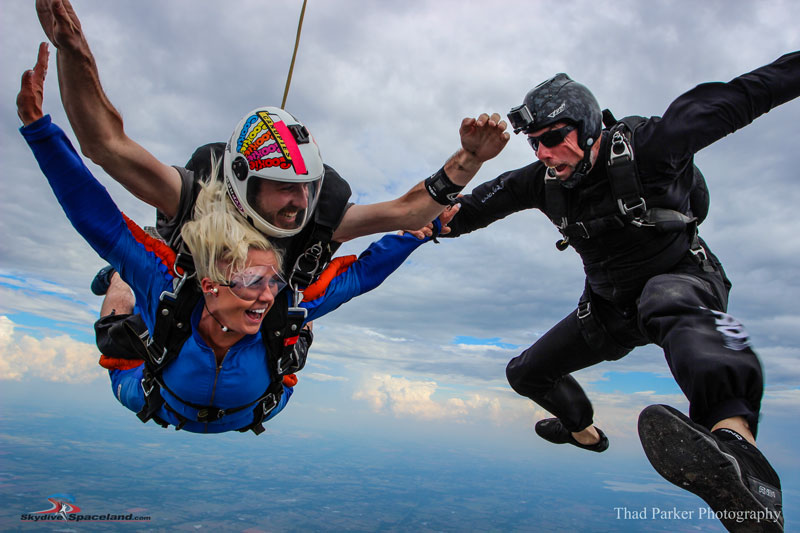
How do you land safely?
Close your eyes and pray. Just kidding! You’ll help your instructor slow the parachute’s descent (flare) with control lines attached to the parachute, while holding your legs straight out in front of you so the instructor touches down first. This way, you won’t have the awkward epic tumble of trying to run off a landing while harnessed to someone who’s behind you! If the winds are light and you’re moving fast, your instructor will likely slide on his rear. If winds are a little stronger, your instructor may tell you to stand up your landing.
Can I pull the cord?
Yes! We WANT you to be an active student of skydiving. But if you don’t, we definitely will!
Can I jump with my friends?
Depending on how many friends are jumping in your group and how big an airplane we are flying, absolutely! Some centers operate smaller planes that only fit 4 people, but we fly turbine aircraft that hold up to 18 or 23 people per flight. If you have a large group, definitely go with a place that has larger aircraft.
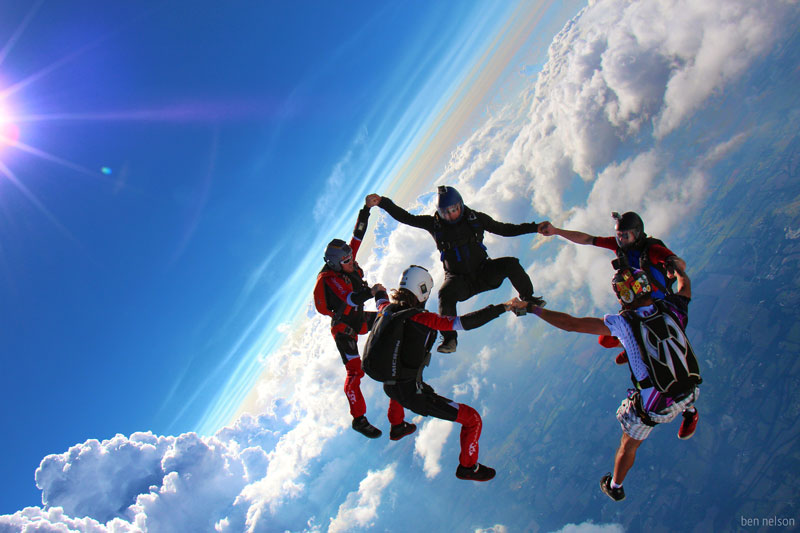
I want to jump with you! But I’m not in Dallas. 🙁
Never fear, we have Skydive Spacelands near Houston, Atlanta, and Miami as well!
I have more questions…
Great! Give us a call at 1-800-SKYDIVE (from Dallas area codes) or 903-364-5103. We’d love to chat! You can also visit us online when you’re ready to book!

